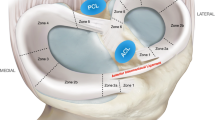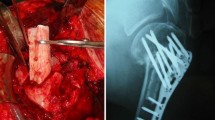Abstract
Successful treatment of tears to the avascular region of the meniscus remains a challenge. Current repair techniques, such as sutures and anchors, are effective in stabilizing the peripheral, vascularized regions of the meniscus, but are not adequate for promoting healing in the avascular region. The purpose of this study was to demonstrate the healing ability of a tissue-engineered repair technique using allogenic chondrocytes from three different sources for the avascular zone of the meniscus. Material and methods: Articular, auricular, and costal chondrocytes were harvested from 3-month-old Yorkshire swine. A 1-cm bucket-handle lesion was created in the avascular zone of each three swine. A cell-scaffold construct, composed of a single chondrocyte cell type and Vicryl mesh, was implanted into the lesion and secured with two vertical mattress sutures. Controls consisted of each three sutured unseeded mesh implants, suture only, and untreated lesions. The swine were allowed immediate post-operative full weight bearing. Menisci and controls were harvested after 12 weeks. Results: In all experimental samples, lesion closure was observed. Gross mechanical testing with two Adson forceps demonstrated bonding of the lesion. Histological analysis showed formation of new tissue in all three experimental samples. None of the control samples demonstrated closure and formation of new matrix. Conclusion: We present preliminary data that demonstrates the potential of a tissue-engineered, allogenic cellular repair to provide successful healing of lesions in the avascular zone in a large animal model.





Similar content being viewed by others
References
Alsalameh S, Jahn B, Krause A, Kalden JR, Burmester GR (1991) Antigenicity and accessory cell function of human articular chondrocytes. J Rheumatol 18:414–421
Arnoczky SP, Warren RF (1982) Microvasculature of the human meniscus. Am J Sports Med 10:90–95
Arnoczky SP (1999) Building a meniscus: biological considerations. Clin Orthop 367S:S244–S253
Brennan FR, Mikecz K, Buzas EI, Glant TT (1995) Interferon-gamma but not granulocyte-macrophage colony-stimulating factor augments proteoglycan presentation by synovial cells and chondrocytes to an autopathogenic T-cell hybridoma. Immunol Lett 45:87–91
Bujia J, Alsalameh S, Sittinger M, Hammer C, Wilmes E, Burmester G (1994) Antigen-presenting cell-function of class-II positive human nasal chondrocytes. Acta Otolaryngol 114:75–79
Busche K, Schlesier M, Runge M, Binder A, Kirchhoff H (1990) T-cell lines responding to Mycoplasma arthritidis and chondrocytes in the Mycoplasma arthritidis infection of rats. Immunobiology 181:398–405
Davies ME, Horner A, Franz B (1994) Intercellular-adhesion molecule-1 (ICAM-1) and MHC class-II on chondrocytes in arthritic joints from pigs experimentally infected with Erysipelothrix rhusiopathiae. FEMS Immunol Med Microbiol 9:265–272
Gertzbein S, Lance E (1976) The stimulation of lymphocytes by chondrocytes in mixed cultures. Clin Exp Immunol 24:102–109
Guilak F, Mow VC (2000) The mechanical environment of the chondrocyte: a biphasic finite element model of cell–matrix interactions in articular cartilage. J Biomech 33:1663
Iberra C, Janetta C, Vacanti CA, et al (1997) Tissue engineered meniscus: a potential new alternative to allogeneic meniscus transplantation. Transplant Proc 29:986–988
Iberra C, Koski JA, Warren RF (2000) Tissue engineering meniscus: cells and matrix. Orthop Clin North Am 31:411–418
Jobanputra P, Corrigall V, Kingsley G, Panayi G (1992) Cellular responses to human chondrocytes. Absence of allogeneic responses in the presence of HLA-DR and ICAM-1. Clin Exp Immunol 90:336–344
O’Shea JJ, Shelbourne KD Repair of locked bucket handle meniscus tears in anterior cruciate ligament-deficient knees. Paper No. 007, Dallas Convention Center, AAOS Meeting 2002
Lee KA, Pierce RA, Mecham RP, Parks WC (1994) Increased mesenchymal cell densities accompanies induction of tropoelastin expression in developing elastic tissue. Dev Dyn 200:53–67
Peretti GM, Gill TJ, Xu JW, Randolph MA, Morse KR, Zaleske DJ (2003) Cell based therapy for meniscal repair—a large animal study. Am J Sports Med 32:1–13
Shakespeare DT, Rigby HS (1983) The bucket-handle tear of the meniscus. A clinical and arthrographic study. J Bone Joint Surg 65B:383–387
Summers KL, O’Donnell JL, Hoy MS, Peart M, Dekker J, Rothwell A, Hart DN (1995) Monocyte-macrophage antigen expression on chondrocytes. J Rheumatol 22:1326–1334
Tiku M, Liu S, Weaver C, Teodorescu M, Skosey J (1985) Class II histocompatibility antigen-mediated immunologic function of normal articular chondrocytes. J Immunol 135:2923–2928
Acknowledgments
This work was funded by the AO/ASIF, Switzerland. We would like to thank Dr. Stuart L. Houser, Transplant Biology Research Laboratory, Director David Sachs, Charlestown, MA, USA for the histological and pathological evaluation. All procedures and experiments were performed in accordance with the “Principles of Laboratory Animal Care” (NIH Publication No. 86–23, revised 1985) and the guidelines of the Massachusetts General Hospital for experiments in animals and animal care.
Author information
Authors and Affiliations
Corresponding author
Rights and permissions
About this article
Cite this article
Weinand, C., Peretti, G.M., Adams, S.B. et al. Healing potential of transplanted allogeneic chondrocytes of three different sources in lesions of the avascular zone of the meniscus: a pilot study. Arch Orthop Trauma Surg 126, 599–605 (2006). https://doi.org/10.1007/s00402-005-0100-7
Received:
Published:
Issue Date:
DOI: https://doi.org/10.1007/s00402-005-0100-7




